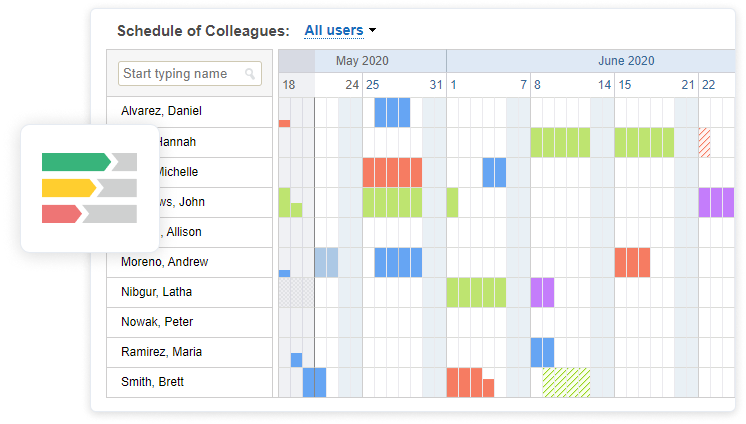
Estimation is a vital part of project management, regardless of whether its primary aim is to develop a budget or set a deadline. Cost estimation and time estimation are equally important – while the former allows for identifying the amount of expenses your project is likely to incur, the latter serves to determine the number of days, weeks or months the work on the project may take. Both kinds of estimates define the price and profitability of the planned business endeavor to a large extent, which makes it pivotal to estimate project costs and duration as accurately as possible.
The credibility and accuracy of estimates significantly depend on the quality and types of information you use to calculate them. In this article, we will review which data you should collect and what exactly you need to know in order to increase the precision of your time estimation process.

How to Increase Time Estimation Accuracy in Projects
1. Understand Project Specifics In-depth
Time estimates are figured based on a detailed work breakdown structure. Simply put, to get a time estimate, you must clarify which tasks and subtasks your project will comprise and identify the volume of resources needed to complete those tasks.
When planning project activities, one should consider that task complexity and the magnitude of workloads determine how much time the project requires. At the same time, the amount of available time directly depends on the size and skillfulness of your workforce. That is to say, each employee has a limited amount of work hours at their disposal per day and week. Hence, you cannot allocate dozens of complicated assignments to an worker and expect them to complete everything within a standard workweek without collapsing. Therefore, to determine the right project duration, you should evaluate the planned workloads in relation to your team size and workers’ time capacities.
Schedule and leave time management tools, such as actiPLANS, are of excellent service in this regard. They provide a comprehensive overview of employee availability by displaying who is attending the workplace as usual and who is absent and for which reasons. Besides, actiPLANS lets users arrange short-term and long-term time off periods in advance, which allows managers to foresee any issues in terms of workforce and time capacities and plan project activities accordingly.

The elaboration of the work breakdown structure and the assessment of needs for resources are just two elements in the estimation and planning processes. You must also develop an all-round picture of your project’s strategic goals, objectives, preferred deliverables and client expectations (if that applies to your case).
A detailed work breakdown helps determine the overall volume of project works and the number of individual activities involved. In turn, when you have a profound knowledge of project goals and objectives, as well as values behind the primary project idea, it becomes easier to set priorities and define areas that call for the most attention, time and effort. With both types of information at hand, you gain a chance to comprehend project complexity and success criteria much better and, thus, develop more realistic time expectations.
Note that the larger and the more complex your project is – the harder it is to figure estimates on your own, regardless of how experienced and competent you are in your field. But even in relatively small projects, it’s just irrational to believe that one person is capable of taking into account all the performance nuances.
For this reason, you should always ask your colleagues to share their opinions regarding probable time estimates for tasks. It’s very likely that their insight into how many hours or days are necessary to fulfill their direct responsibilities is at least a bit deeper than yours. Thus, an open interprofessional discussion of estimates will surely do no harm. On the contrary, such a conversation will promote estimation accuracy and make it easier for your team to adhere to designed schedules in the long term.

2. Seek Expert Opinion and Use Historical Data
Professional experience and the depth of one’s knowledge in the sphere of project realization substantially define the accuracy of time estimates. But how to be in case you’re dealing with a completely unfamiliar kind of project? What to do if you don’t know where the work breakdown should even start from and if you can’t trust your own judgment while evaluating employees’ suggestions on task estimates?
Such a situation is every manager’s nightmare, but it has a simple solution – for more accurate time estimation in unfamiliar projects, you may always resort to expert judgment and analogous estimating with historical data.
By their very definition, experts are those who possess extensive competence in the field of your interest. Ergo, they can assist your team in bridging the gaps in knowledge and provide you with answers to all the questions you may have.

As for historical data, they can serve as a reference for creating new project estimates based on the experiences from projects completed in the past. However, when comparing your project with others in such a way, you need to make sure they have a lot in common. Their attributes, contents and goals must be similar to a significant degree.
Also, remember that even though historical data is a valuable source of information, it’s not ideal. The context where your project is to be performed may widely vary from those where previous projects were executed. Thus, when implementing estimation by analogy, it is highly recommended to conduct an additional analysis of the present-day business environment to locate factors that might affect your project differently. As a result, you will arrive at more accurate forecasts.
3. Assess Risks
A famous American politician and a former Secretary of Defense, Donald Rumsfeld once said:

This seemingly bizarre phrase perfectly applies to the project management reality and implies that no matter how hard you try to identify risks and uncertainties, you cannot detect them all. Your project will always face the threat of unexpected incidents that you won’t be able to predict. Still, risk assessment is core to more accurate time estimation. Moreover, there is a way to reduce the negative impacts of even unknown unknowns and complete your project on schedule when the unpredicted appears on the doorstep.
The fewer unknown unknowns there are – the better. Hence, speaking in Rumsfeld’s language, you should strive to turn as many unknowns into knowns as possible. Otherwise stated, a comprehensive risk analysis is necessary to identify a diversity of factors that could threaten your project realization efforts, cause schedule delays and prevent your team from completing the planned works on time.
Once you do that, you should count how much time may be required to manage undesired events if they happen and allocate a buffer amount of time for this purpose. Though it may be hard to persuade yourself to take unknown risks seriously, you can benefit from assuming them as well. A reasonable backup plan is always a guarantee that everything goes smoothly despite the circumstances.
Ready to Improve Project Time Estimation?
After calculating estimates for separate project tasks and activities by using any of the above sources of information – a work breakdown structure, team discussion, historical data, expert opinion or risk analysis – sum them up to arrive at the total project estimate and design the ultimate project schedule.
Your final duty with regards to time estimation will be the adherence to preset project timeframes. After the actual work commences, it is rarely possible to avoid at least minor changes to scope, tasks and objectives. However, when encouraging every possible change, you increase the probability of missed deadlines.
Remember that the main thing here is to stay flexible but critical. You should allow only those alterations that won’t lead to unchecked project delays and won’t reduce your chances for success.












































